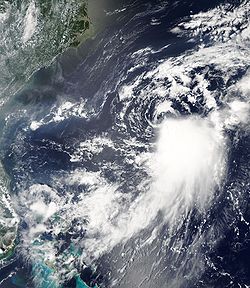
A recent increase in the intensity of tropical cyclones in the Arabian Sea may be a side effect of increasing air pollution over the Indian sub-continent, a new multi-institutional study has found.
Until recent decades, cyclones in the Arabian Sea tended to be relatively weak storms. This was attributed to a naturally occurring vertical wind shear over the sea, which tended to weaken and ultimately break up developing storms.
But the study’s investigators have found that wind circulation patterns over the Arabian Sea are changing, reducing vertical wind shear and allowing stronger storm development.
“We are showing that pollution from human activity – as simple as burning wood or driving a vehicle with a diesel engine – can actually change these massive atmospheric phenomena in a significant way. It underscores the importance of getting a handle on emissions in the region.”
The weakening wind patterns over the past 30 years have corresponded with a buildup of aerosols in the atmosphere over India, which deflect sunlight from the surface, creating dimming at ground level, the researchers said. The aerosol buildup creates formations known as “atmospheric brown clouds,” in which smog from diesel emissions, soot and other by-products of biomass burning accumulates and becomes widespread to a degree significant enough to be a climatic force.
The 1.9-mile-thick brown cloud has been linked to altered rainfall patterns in South Asia. The brown clouds’ large-scale dimming effect also mitigates the warming of the ocean due to greenhouse gas-driven climate change.
Historically, the onset of the summer monsoon season produced strong winds in the lower and upper atmospheres that traveled in opposite directions – vertical wind shear – which made formation of cyclones virtually impossible in July and August. Wind shear has the effect of cutting off the top of a storm – its exhaust, so to speak – from its power source near the sea’s surface, weakening the storm and causing its eventual disintegration.
Thus, despite warm sea surface temperatures – which normally contribute to intensifying cyclones – the Arabian Sea has averaged just two or three cyclones per year, and those tended to form outside the monsoon season, when wind shear is diminished.
The researchers identified a trend of increasingly strong cyclones in the months immediately preceding monsoon season in the region. In June 1998, a significant cyclone struck Gujarat, India, killing nearly 2,900 people. In June 2007, Cyclone Gonu, a category 5 storm with winds in excess of 156 miles per hour, caused $4 billion in damage when it made landfall in Iran. In June 2010, a category 4 storm, Cyclone Phet, struck the coastlines of Pakistan and Oman, causing nearly $2 billion in damage.
“We thought, ‘Wow, there’s something going on here,’ where the strongest storms ever in the region occurred within a few years of each other,” Evan said.
Using findings from direct observations and model studies of atmospheric brown clouds made by Scripps Institution of Oceanography climate and atmospheric scientist Veerabhadran Ramanathan, a study co-author, Evan and his colleagues posit that the brown cloud over India disrupts normal air circulation and inhibits summertime warming of the surface, causing sea surface temperatures in the northern Arabian Sea to more closely match cooler temperatures closer to the equator.
“The net effect of this pollution is it cools the water,” Evan said. “You can think of it as being like a sponge that absorbs sunlight that otherwise would have reached the ocean.”
The team also found that the brown clouds changed the circulation of the atmosphere in such a way as to reduce the climatological vertical wind shear, thus leading to more intense storms.
“It’s a fairly recent change in the circulation, the vertical wind shear, that seems to be allowing storms to intensify now, rather than break up as they normally would do,” Evan said.
“The only thing that’s been systematically changing in this part of the world is pollution,” he added. “There’s been a huge growth in pollution from human activity from the Indian subcontinent over the last 60 or so years, a six-fold increase in emissions of pollutions like black carbon and sulfates.”
Ramanathan said, “This study adds another major dimension to a long list of negative effects that brown clouds have, including rainfall reduction, Himalayan glaciers melting, significant crop damages and deaths of a million or more annually. The one silver lining is that the atmospheric concentrations of these pollutants can be reduced drastically and quickly using available technologies.”
Evan noted that unless air pollution emitted from the Indian subcontinent is reduced, it is possible that strong cyclones in the Arabian Sea may become more commonplace. This has the potential to cause additional billions of dollars in damage, more loss of life and disruptions to shipping traffic in the Arabian Sea, the Gulf of Oman and the Persian Gulf.



